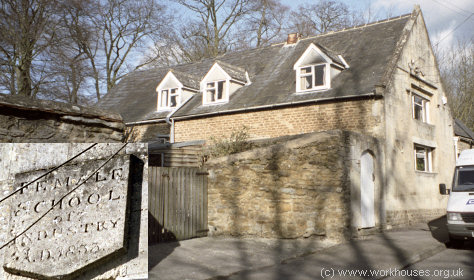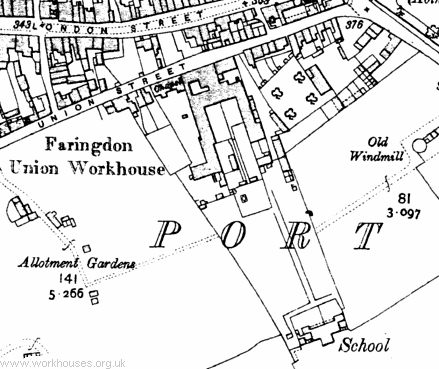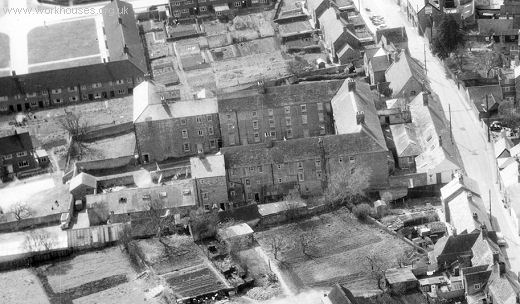Faringdon, Berkshire
Up to 1834
(Great) Faringdon had a workhouse from around 1725. A report from the town in the second edition of An Account of Several Workhouses..., published in 1732, noted that:
Buckland opened a workhouse in around 1739 (Thomas, 1971).
Lechlade had a workhouse by 1735. In 1763, a new building was was erected at the north side of St John's bridge, on the site of a 13th-century hospital. It had ceased operation by 1802, when the property was sold.
In around 1801, Faringdon erected a new workhouse under the terms of Gilbert's Act of 1782. By 1832, the poor were being "farmed" by a contractor. For an annual fee of £2,200 he operated the workhouse and provided each inmate with "good meat dinners three days at the least in each week" and "mutton or such other diet as may be suitable" for any that were sick. A regime of hard labour and strict discipline prevailed.
Faringdon was also the location of a Female School of Industry — such establishments provided pauper children with training, mostly in domestic and agricultural skills. The building dates from 1833 and was located on London Street (see map). The large part of the building still survives as a private house.

Faringdon Female School of Industry, 2000.
© Peter Higginbotham.
After 1834
Faringdon Poor Law Union was formed on 2nd February 1835, one of the first unions to be declared following the 1834 Act. Its operation was overseen by an elected Board of Guardians, 34 in number, representing its 30 constituent parishes as listed below (figures in brackets indicate numbers of Guardians if more than one):
Berkshire:
Ashbury, Baulking, Bourton, Buckland (2), Buscot, Charney (Bassett), Coleshill, Compton and Knighton, Great Coxwell,
Little Coxwell, Eaton Hastings, Great Faringdon (4), Little Faringdon, Fernham, Hatford, Hinton (Waldrist),
Kingston Lisle and Fawler, Langford, Longcott, Longworth, Pusey, Shellingford, Shrivenham, Stanford (in the Vale), Uffington, Watchfield, Woolstone.
Oxfordshire:
Grafton, Kelmscott, Radcott.
Gloucestershire: Later addition — Lechlade (from 25th January 1836).
The population falling within the Union at the 1831 census had been 12,992 with an average (1832-35) poor-rate expenditure of £11,914.
The original union workhouse was an adaptation of the existing workhouse building for which the Poor Law Commissioners eventually authorised the sum of £1500.
The process of setting up the new Faringdon Poor Law Union was overseen by Assistant Poor Law Commissioner Edward Gulson, who gave a glowing report of his experiences in the town:
I united twenty-nine parishes to Faringdon, under order of the Board of Poor Law Commissioners, dated February 2nd, 1835, many of which were highly pauperized. They have all derived benefit from that which, under the feeble administration of the parish vestry, had been useless to Faringdon alone.
Although the interior arrangements of the workhouse were not such as to render the management so efficient as it will be when the alterations now in progress, and which are estimated to cost 900l., are completed, yet they were sufficient to make it immediately available for the reception of the paupers of the whole union. The board of guardians have therefore, with the able, energetic, and most valuable co-operation of their chairman, Viscount Barrington, carried out the principles of the Poor Law Amendment Act to a greater extent than in any union within my district, and the results have been satisfactory in the highest degree.
All out-door relief to able-bodied labourers is discontinued. The workhouse now contains seventy-four inmates from the whole union, being only eleven more than from the parish of Faringdon alone, under the old system. Of the first eighty-seven labourers with families, to whom out-door relief was refused in the months of February and March, and most of whom had been constant hangers on the parish fund, and to all of whom an order for the workhouse was given for themselves and their families, not one-half availed themselves of the offer, but immediately found means of providing themselves.
Of the rest who successively accepted the proffered assistance, some staid one day, some two, some three, and, excepting two, none remained more than four days. Being anxious to ascertain whether the application of this principle had inflicted hardship upon these men and their families, and whether the denial of out-door relief had driven them from their own villages to seek an uncertain subsistence elsewhere, I devoted several days, in the parishes to which they belonged, to the purpose of ascertaining their real situations, by visiting them at their own homes, I found that, of the 85 men, 78 were at work in their respective parishes, and two others in the immediate vicinity, and not one of them had his dwelling broken up.
Thus were 85 men with their families at once relieved from the degradation of pauperism, and by being thrown upon their own resources, taught that they could honestly and independently support themselves and their families by their industry; most of them had at that season been upon the parish books for three years.
According to Pevsner, a new union workhouse was built in 1846 to a design by "Foder" (perhaps a misspelling of S O Foden who designed a number of workhouse buildings including Hungerford, Aylesbury and Lexden and Winstree). It was situated on the then Union Street, later renamed Ferndale Street. Its location and layout can be seen on the 1899 map below:

Faringdon workhouse site, 1912
The main building was an unusual U-shaped layout, three storeys in height. The area within the U was divided into four walled exercise yards for the different classes of workhouse inmate. A single-storey entrance block fronted onto Union Street at the north of the site, with a chapel located at the west side. A workshouse school was located at the far south of the site.

Faringdon workhouse aerial view from the east.
In 1930, the establishment was taken over by Berkshire County Council and operated until about 1933 as a Public Assistance Instiution .In 1935, the building, with eleven acres of land, was put up for sale at a price of £2,000. The main block was subsequently converted into flats which continued in use until the late 1960s.
No trace of the workhouse now remains. The site has been redeveloped to provide accommodation for the elderly known as Brackendale.
Staff
Inmates
Records
Note: many repositories impose a closure period of up to 100 years for records identifying individuals. Before travelling a long distance, always check that the records you want to consult will be available.
- Berkshire Record Office, Berkshire Record Office, 9 Coley Avenue, Reading, Berks RG1 6AF. Holdings include: Guardians' minute books (1835-1930); Births (1835-32); Baptisms (1927-33); Deaths (1875-1933); Assessment Committee minutes (1862-1912); etc.
Bibliography
- Higginbotham, Peter Workhouses of London and the South East (2019)
- Thomas, E.G. (1971) The Treatment of Poverty in Berkshire, Essex and Oxfordshire, 1723-1834 (London Univ. Ph.D. thesis)
Links
- None.
Unless otherwise indicated, this page () is copyright Peter Higginbotham. Contents may not be reproduced without permission.


